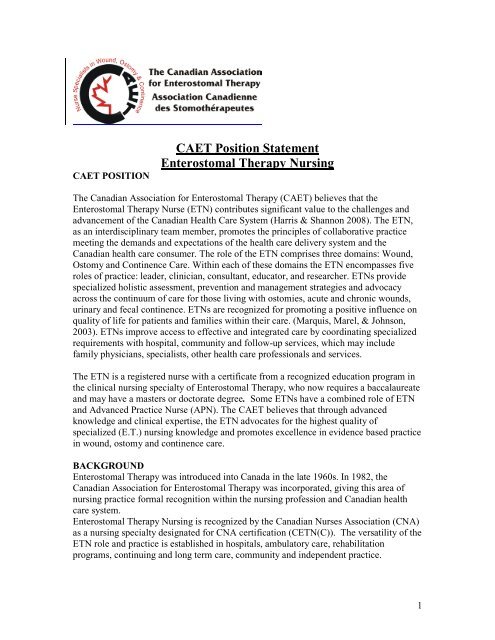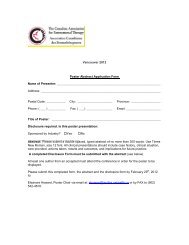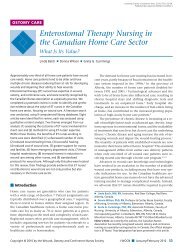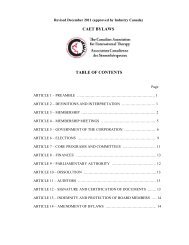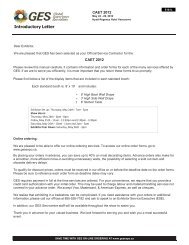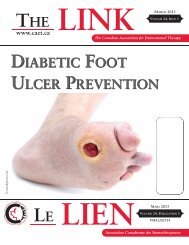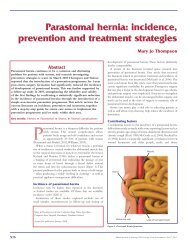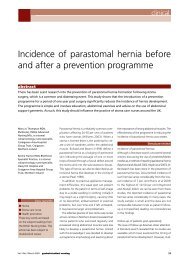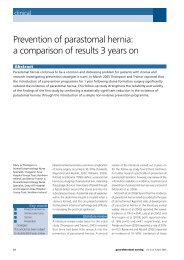CAET Position Statement Enterostomal Therapy Nursing
CAET Position Statement Enterostomal Therapy Nursing
CAET Position Statement Enterostomal Therapy Nursing
You also want an ePaper? Increase the reach of your titles
YUMPU automatically turns print PDFs into web optimized ePapers that Google loves.
<strong>CAET</strong> POSITION<br />
<strong>CAET</strong> <strong>Position</strong> <strong>Statement</strong><br />
<strong>Enterostomal</strong> <strong>Therapy</strong> <strong>Nursing</strong><br />
The Canadian Association for <strong>Enterostomal</strong> <strong>Therapy</strong> (<strong>CAET</strong>) believes that the<br />
<strong>Enterostomal</strong> <strong>Therapy</strong> Nurse (ETN) contributes significant value to the challenges and<br />
advancement of the Canadian Health Care System (Harris & Shannon 2008). The ETN,<br />
as an interdisciplinary team member, promotes the principles of collaborative practice<br />
meeting the demands and expectations of the health care delivery system and the<br />
Canadian health care consumer. The role of the ETN comprises three domains: Wound,<br />
Ostomy and Continence Care. Within each of these domains the ETN encompasses five<br />
roles of practice: leader, clinician, consultant, educator, and researcher. ETNs provide<br />
specialized holistic assessment, prevention and management strategies and advocacy<br />
across the continuum of care for those living with ostomies, acute and chronic wounds,<br />
urinary and fecal continence. ETNs are recognized for promoting a positive influence on<br />
quality of life for patients and families within their care. (Marquis, Marel, & Johnson,<br />
2003). ETNs improve access to effective and integrated care by coordinating specialized<br />
requirements with hospital, community and follow-up services, which may include<br />
family physicians, specialists, other health care professionals and services.<br />
The ETN is a registered nurse with a certificate from a recognized education program in<br />
the clinical nursing specialty of <strong>Enterostomal</strong> <strong>Therapy</strong>, who now requires a baccalaureate<br />
and may have a masters or doctorate degree. Some ETNs have a combined role of ETN<br />
and Advanced Practice Nurse (APN). The <strong>CAET</strong> believes that through advanced<br />
knowledge and clinical expertise, the ETN advocates for the highest quality of<br />
specialized (E.T.) nursing knowledge and promotes excellence in evidence based practice<br />
in wound, ostomy and continence care.<br />
BACKGROUND<br />
<strong>Enterostomal</strong> <strong>Therapy</strong> was introduced into Canada in the late 1960s. In 1982, the<br />
Canadian Association for <strong>Enterostomal</strong> <strong>Therapy</strong> was incorporated, giving this area of<br />
nursing practice formal recognition within the nursing profession and Canadian health<br />
care system.<br />
<strong>Enterostomal</strong> <strong>Therapy</strong> <strong>Nursing</strong> is recognized by the Canadian Nurses Association (CNA)<br />
as a nursing specialty designated for CNA certification (CETN(C)). The versatility of the<br />
ETN role and practice is established in hospitals, ambulatory care, rehabilitation<br />
programs, continuing and long term care, community and independent practice.<br />
1
The five roles of ETN practice are interrelated and dependant on the needs of clients,<br />
families, communities and other health care professionals within their respective care<br />
environment. The roles demonstrated by the ETN are:<br />
LEADER<br />
As a leader, the ETN advances <strong>Enterostomal</strong> <strong>Therapy</strong> nursing practice and promotes quality<br />
client care. As a role model, resource, facilitator, advocate, decision maker and coordinator, the<br />
ETN demonstrates excellence in leadership.<br />
As a change agent and through innovative practice, the ETN is instrumental in shaping social and<br />
economic policy. This leadership is exercised within the three domains of the ETN specialty<br />
locally, regionally, provincially, nationally and internationally.<br />
CLINICIAN<br />
The ETN provides research and evidence-based practice in a specialized clinical care and<br />
management environment. As a clinician, the ETN provides comprehensive assessment,<br />
recommendations, consultation and intervenes directly and indirectly in the management and<br />
prevention of complex practice concerns within the identified domains of the specialty.<br />
CONSULTANT<br />
The ETN promotes effective care through formal and informal consultation and leadership at<br />
professional and corporate levels. Consultation may involve but is not limited to clinical practice<br />
issues, policy and guideline development, program development, product evaluations and<br />
recommendations. (Turnbull, 2001).<br />
EDUCATOR<br />
The ETN assist clients in making informed decisions regarding their health through education and<br />
teaching by providing consistent, reliable and accurate information. As an educator for other<br />
health care professionals and students, the ETN promotes quality <strong>Enterostomal</strong> <strong>Therapy</strong> <strong>Nursing</strong><br />
practice through teaching, mentoring, programme development and quality monitoring.<br />
RESEARCHER<br />
The ETN is committed to strengthening the <strong>Enterostomal</strong> <strong>Therapy</strong> <strong>Nursing</strong> specialty through the<br />
participation and application of translational research and evidence based practice. Through<br />
inquiry, identification of research topics and active investigation, the ETN is able to impact and<br />
evolve clinical practice and standards of care.<br />
REFERENCES<br />
<strong>CAET</strong> (2008). <strong>Enterostomal</strong> <strong>Therapy</strong> <strong>Nursing</strong> Research Study Fact Sheet. Marketing Package.<br />
Canadian <strong>Nursing</strong> Association. (2003). <strong>Position</strong> <strong>Statement</strong>: Clinical Nurse Specialist.<br />
Harris, C., Shannon, R. (2008). An Innovative <strong>Enterostomal</strong> <strong>Therapy</strong> Nurse Model of Community Wound Care<br />
Delivery. JWOCN, March/April .<br />
Marquis, P., Marel, A., Johnson, B. (2003). Quality of Life in Patients with Stomas: The Montreux Study Ostomy Wound<br />
Management; 49 (2); pp. 48-55<br />
Turnbull, G.B. (2001). Ostomy Supplies out of Balance Ostomy Wound Management, 47 (4); pp. 2-3<br />
2
Acknowledgements<br />
Mary Engel<br />
Regional Director Ontario<br />
Teri Schroeder<br />
Regional Director<br />
Prairies/NU. NWT.<br />
Mary Hill<br />
President<br />
Kathryn Kozell<br />
Past President<br />
<strong>CAET</strong> Board<br />
Patti Barton<br />
Jo Hoeflok<br />
Karen Lagden<br />
Samara Rao<br />
Sandy Roberts<br />
Val Steele<br />
Harvey Schwartz<br />
Manager <strong>CAET</strong> National Office<br />
3


